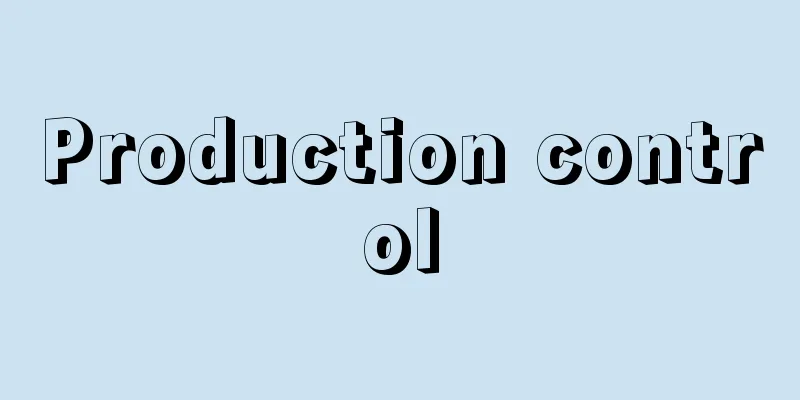Production control

|
It is a series of management activities carried out to effectively operate each element related to production, such as machinery, equipment, raw materials, and labor, so that products of a certain quality and quantity are delivered on time. In the narrow sense, process control refers to progress control or progress management, and aims to smooth the flow of the entire production process by regulating and controlling the progress of work in each production process according to plan while paying attention to the product. The specific content of process control varies depending on the production form (made-to-order production/forecast production, or assembly production/processing production) and the production method (individual production/mass production, etc.). Here, we will mainly explain the work content of process control for made-to-order production, which requires the most number of processes. When a manufacturing order is issued to the manufacturing department based on an order, stating what product to make, by when, and in how many, the department estimates the necessary materials and parts according to the design drawings and arranges for their procurement. This is called material planning. In parallel with this, standards are decided for the processes required for manufacturing, including the order of the processes, materials to be used, machines, jigs, tools, and working hours. This is called procedure planning. Next, the amount of work is allocated to each process in accordance with the procedure plan (man-hour planning), and adjustments are made by outsourcing as necessary (outsourcing planning). Furthermore, a daily work schedule (schedule plan) is created for each workplace, taking into account the amount of work, on-site capacity, and the urgency of the work. Once manufacturing has begun according to the above plans, production control will be put into place from that point on. First, it is determined whether work at each process is progressing according to plan, and the plan is revised or accelerated as necessary. This is called progress management. Adjustments are also made to the amount of labor and the operating rate of machines (slack management). Finally, delivery is made. In a broad sense, process management includes all of the above processes from order receipt to delivery, but in a narrow sense it refers to the activities at each stage of production planning and production control, and is sometimes used synonymously with progress management. As such, the function of process management is broad, including planning and control functions, so how to organize it becomes an important issue. Process control should be considered from a company-wide perspective, but its position in the organization is also important in making process control effective. Currently, the organizational forms widely adopted are a centralized organization in which the process control function is concentrated under the factory manager, and a department-decentralized organization in which each manufacturing department has its own staff and is controlled centrally. The former is suitable for factories that manufacture a single or similar product, while the latter is suitable for factories that manufacture a wide variety of products with quite different manufacturing methods. [Mitsuo Takahashi] Takayoshi Namiki, "Practical Process Management", 4th Edition (1982, Nikkan Kogyo Shimbun) Source: Shogakukan Encyclopedia Nipponica About Encyclopedia Nipponica Information | Legend |
|
一定の品質・数量の製品を納期にまにあうように、機械・設備、原材料、労働力など生産にかかわる各要素を効果的に運用するために行われる一連の管理活動をいう。工程管理は、狭義には進度管理または進捗(しんちょく)管理をさすように、各生産工程について作業の進行が計画どおりに行われるよう、生産物に注目しつつ時間計画の下に規制・統制することによって、全生産工程の流れを円滑にすることを目的とする。 工程管理の具体的内容は、生産形態(注文生産・見込み生産、あるいは組立て生産・加工生産)や、生産方式(個別生産・大量生産など)によって異なる。ここでは主として、もっとも多くの工程が要求される注文生産の場合の工程管理について、その業務内容を説明する。 受注に基づいて、どのような製品を、いつまでに、どれだけつくれといった内容の製造命令書が製造部に出されると、製造部では、設計図に従って必要な材料や部品を見積もり、調達の手配をする。材料計画である。それと並行して、製造に必要な工程について、工程の順序、使用材料、機械、治工具、作業時間などの基準が決められる。手順計画とよばれる。続いて手順計画に沿って各工程に仕事量が割り付けられ(工数計画)、必要に応じて外注で調整する(外注計画)。さらに各職場ごとに、仕事量、現場の能力、作業の緊急度などを考慮して、毎日の作業予定(日程計画)がつくられる。以上の各計画に従って製造が開始されると、それ以後は生産統制が行われることになる。 まず各工程の作業が計画どおりに進んでいるかどうかが把握され、必要に応じて計画の修正・促進が図られる。進度管理とよばれる。また、労働量や機械の操業度の調整(余力管理)が行われる。最後に納品が行われる。工程管理は、広義には、以上の受注から納品までの全プロセスが含まれるが、狭義には、生産計画、生産統制の各段階における諸活動をさし、とくに進度管理と同義に用いられることもある。 このように工程管理の機能は、計画機能と統制機能をもち、広範囲にわたるから、その組織をどうするかが重要な課題となる。 工程管理は全社的な立場で考慮されるべきであるが、組織上の位置づけも、工程管理の実効をあげるうえで重要となる。現在広く採用される組織形態は、工程管理の機能を工場長の下に集中させた中央集権型組織と、製造部によって独自のスタッフをもち、中央で統制する分課分権制組織である。前者は単一あるいは同種類製品を製造する工場に適しているのに対し、後者は製造形態のかなり異なった多品種製造工場に適した組織形態である。 [高橋三雄] 『並木高矣著『工程管理の実際』第四版(1982・日刊工業新聞社)』 出典 小学館 日本大百科全書(ニッポニカ)日本大百科全書(ニッポニカ)について 情報 | 凡例 |
<<: Caesaropapism (English spelling) German
Recommend
Layered
It refers to wearing long kimonos layered on top o...
Wholesaler - Toiyaba
A facility that managed the transfer of horses and...
Psychopathology
…In 1888, Ribot became the full-time professor of...
smilacin
…The dried rhizomes are used medicinally and are ...
Tokugawa Musei
Actor and broadcast entertainer. His real name wa...
Oxidase - Oxidase
A type of oxidoreductase. In the broad sense, it ...
Portulaca oleracea var. gigantea (English notation) Portulaca oleracea var gigantea
… [Mitsuru Hotta]... *Some of the terminology tha...
PPBS - PPBS
It is an abbreviation for planning-programming-bu...
Negative name - Fumyou
Since the Heian period, in ancient and medieval t...
Sanae Takada
Educator and politician. Born in Tokyo. His pen n...
Simmental
... docile and easy to keep. (3) Simmental: Nativ...
Indolyl acetic acid
…It is synthesized by the Fischer method, in whic...
Change of country
This refers to the reassignment of feudal lords d...
Taira no Yasuyori - Taira no Yasuyori
Date of birth and death unknown. Late Heian perio...
New opening - Shinkai
〘 noun 〙 (also "shingai") 1 (━ to do) Th...



![Caucasus [mountain range] - Caucasus](/upload/images/67cb3ca31ebbc.webp)





